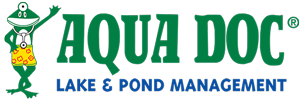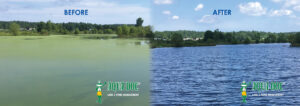We often get this question from either a new home owner that has recently purchased a home with a pond or from someone who has recently put in a new pond. A classic case of- OK, now what? I wish there was a straight forward way of answering this question and trust me if you look on the internet you will see millions of articles telling you how to “accomplish” this. Some I would say are helpful- others not so much. Usually a good maintenance strategy, or what I like to call a management program strikes a balance between the lake or ponds reference conditions, i.e. what the waterbody is realistically able to support, and the needs or desires of the property owner.
What is the difference between a Lake and a Pond?
There are two basic definitions, one is scientific and the other is more for practical use. Scientifically, if sunlight is able to reach the bottom of the waterbody throughout- it is a pond. A lake on the other hand will have an open water zone, known as the profundal zone where light cannot penetrate. However, for practicality The State of Ohio defines any water impoundment 5 acres or greater as a lake.
What is algae, and where does it come from?
Algae are photosynthetic (light harvesting) organisms. They range from single cells to fairly complex multi-cellular organisms. Some algae, like Chara, have such a complex structure that they can even be mistaken for aquatic plants. Nonetheless, this is a very diverse group of organisms, and most growth forms are tiny and need to be identified with the use of a microscope. Algae growth in freshwater is often dictated by environmental cues such as, sunlight, heat, and nutrient concentrations. Warm, sunny growing conditions, along with excess nutrients such as nitrogen and phosphorus can often lead to issues with algae blooms.
Is it really necessary to identify the weeds in my pond in order to control them?
Yes. Aquatic herbicides are designed and manufactured to target certain plant species and not others. In fact, many of the products that have been brought to market recently are really only designed to target invasive plants species. These plants commonly have the ability to outcompete native plants by forming dense mats that crowd out sunlight. As a good steward of the environment it is important to have working knowledge of the plant you are intending to control.
What is an Acre-Foot?
This unit of measure is commonly listed on most label rates, and if you are asking yourself this question, you may want to consider contacting a professional applicator, to help you with your project. An acre-foot is the volume of water that would cover one acre of land one foot deep, it is equal to 325,851 gallons. This is an easy way to deal with volumes of water out in the field allowing for rapid conversion and rate calculations.
Do I need aeration in my pond?
Typically, when I talk to people about aeration, I am talking about bottom diffused aeration. These systems are comprised of an on-shore air compressor connected to bottom weighted tubing leading to a diffuser air station along the lake or pond bottom. By creating a column of air, a constant mixing action occurs, circulating bottom water to the surface and back down again. This prevents thermal stratification, which commonly leads to dissolved oxygen loss at different times of the year. Dissolved oxygen testing should be able to lead you in the right direction on a lake or pond aeration project.
What type of fish should I have in my pond? What I have found over the years, is that the vast majority of people with ponds are not interested in actively managing their fisheries. Most folks want a pond that is relatively care free, that they can go to from time to time and catch fish with their children or grandchildren. For these people and most of my customers I recommend a simple bass and bluegill pond fishery, that can also be supplemented with fathead minnows. From there the complexity grows, generally larger ponds can handle a higher diversity of fish more easily. For more advanced stocking, some other fish that are conducive to our region can include Hybrid bluegill, Red ear sunfish, Yellow perch, Smallmouth bass, Crappie, Hybrid striped bass, and even Northern pike.
Carter L. Bailey, Aquatic Biologist, AQUA DOC Inc.


